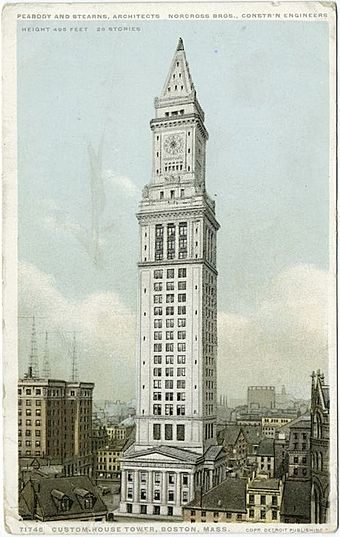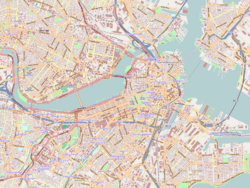Custom House District facts for kids
Quick facts for kids |
|
|
Custom House District
|
|

Custom House Tower (1915), built on top of the 1849 Boston Custom House
|
|
| Location | Boston, Massachusetts |
|---|---|
| Architect | Multiple |
| Architectural style | Skyscraper, Art Deco, Late 19th And 20th Century Revivals |
| NRHP reference No. | 73000321 |
| Added to NRHP | May 11, 1973 |
The Custom House District is a special area in Boston, Massachusetts, known for its history. It's called a historic district because it has many old and important buildings. This district is located in Downtown Boston, between streets like Purchase Street, Kilby Street, and State Street.
The area is named after the Boston Custom House, a large building from 1849 on State Street. The district covers about 16 acres and has around 70 buildings. Many of these are 19th-century buildings that were used for trade and business. You'll also find several tall skyscrapers from the early 1900s, including the famous Custom House Tower built in 1915.
This district is a great example of early urban planning, which is like designing a city. In 1805, a group called the Broad Street Associates hired a famous architect named Charles Bulfinch. He helped plan how the area south of Long Wharf and State Street would grow as a business center.
The Custom House District has a mix of building styles. Some are from the Federal period (early 1800s) and followed Bulfinch's plans. But because the area grew for over a century, you can see many different architectural styles. For example, some 19th-century warehouses are made of granite, which was different from the usual brick buildings of that time. The State Street Block, built in 1858, is another important building designed by Gridley James Fox Bryant.
The Custom House District was added to the National Register of Historic Places in 1973. This is a list of places in the United States that are important to history. When it was first listed, only buildings from the 19th century were considered historically important. But in 1996, the list was updated to include important skyscrapers built up to 1928. This meant more buildings in the district were recognized for their historical and architectural value.
Important Buildings in the District
Many buildings in the Custom House District are considered "contributing properties." This means they add to the historical importance and special character of the district. Here are a few examples:
- The Appleton Building (1900) at 4 Liberty Square.
- The Batterymarch Building (1928) at 54–68 Batterymarch Street. This building was also named a Boston Landmark in 1995.
- The Board of Trade Building (1901) at 2–22 Broad Street.
- The Boston Custom House (1849) and the Custom House Tower (1915) at McKinley Square. These are two of the most famous buildings in the district.
- The Broad Exchange Building (1903) at 88 Broad Street.
- Some of the Broad Street Association warehouses (around 1805) at various addresses on Broad Street and Milk Street. Some of these are also Boston Landmarks.
- The Central Wharf warehouses (1816) at 146–176 Milk Street.
- The Cunard Building (1901) at 122–130 State Street.
- The Flour and Grain Exchange Building, also known as the Boston Chamber of Commerce (1892), at 177 Milk Street.
- The Insurance Exchange Building (1923) at 24–44 Broad Street.
- The State Street Block (1857) at 177–199 State Street.




